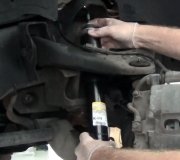First of all, there's two things that most people aren't aware of. The first is with the type of bushings on your shock absorbers, it is easy to over-tighten the nuts. I don't know if yours have a metal sleeve inside or not. If there is a sleeve, just tighten the nuts like normal, (common sense). If they're under-tightened, the forces on the shock absorber will allow the sleeves to move, and that will increase the gap which causes more noise and more wear. If that is caught early enough, simply tightening the loose nut to specs is all that's needed to stop the noise. When the looseness can't be felt by hand, it can be identified by removing the retaining washer and you'll see the shiny chewed up area indicating the part was sliding around. If there is no sleeve, the nut is only supposed to be tightened as much as necessary to make the bushing expand to the same diameter as the retaining washer that goes against that bushing. That type can easily be over-tightened. Doing so will greatly decrease the life of the rubber.
The second issue has to do more with front shock absorbers, but it's still important to be aware that anything that has a rubber bushing that attaches to a part that rotates or swivels as the vehicle bounces up and down, has to be tightened when the vehicle is sitting at normal ride height. In the shop, since I was an alignment specialist, I had a drive-on hoist, so the cars were always at normal ride height. The parts could simply be installed and tightened. When the car was on a regular hoist that let the wheels hang down, the parts could be installed, but the nuts and bolts couldn't be tightened until the car was lowered to the ground. That either meant crawling underneath once the car was lowered to the ground, or, I could finish the job if the car was coming to me for an alignment. If the bolts are tightened while the car is raised up and the wheels are hanging down, that will clamp the bushings in that position, then when the car is on the ground and the parts swivel, those bushings are clamped in a permanent twist. It doesn't take much bouncing up and down on the road to over-flex the rubber and tear the bushings from any metal parts they're supposed to be bonded to. Once the rubber tears free, the pounding action will rapidly destroy them, and it won't be long before there's metal-on-metal rattling over bumps in the road.
You can also remove the shock absorbers, then drive the vehicle to see if the noise is gone. If it is, check those retaining washers for evidence the nuts were under-tightened, but it also possible for a shock absorber to be the cause of the noise. That is not real common in any shock absorber, and especially in new ones, but it is not unheard of.
Other than that, the Chassis Ear, and visiting an alignment shop are my best recommendations. You can find the Chassis Ear on Amazon, or the guys who drive the tool trucks to the repair shops each week can order them too. The tool costs a lot less on Amazon.
Tuesday, September 29th, 2015 AT 5:54 PM



